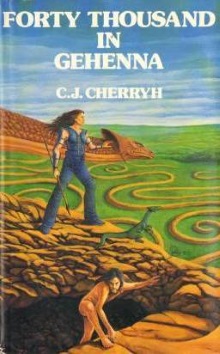
I’ve been reading this as it was sold in an omnibus volume together with Merchanter’s Luck. This is course another novel by C.J. Cherryh that is set in her Alliance-Union universe. The two novels are however extremely different in tone, scope and complexity. Here the narrative spans hundreds of years and a score of characters. Considering how I disliked how the earlier novel focused almost exclusively on the PTSD of a single character, it’s no surprise that I like this a whole lot more.
During a period of entente between the Alliance and the Union, the Union government embarks on a plan to colonize a planet that has been found to support life. Over forty thousand colonists are dispatched to the planet named Gehenna, most of them consisting of clones, azis, who have been brainwashed to be subservient. The planet hosts native life of its own, most notably the reptilian calibans and ariels. The surveyors determine that they are non-sapient though the colonists do endeavor to preserve them. The tough local conditions wear down the colonists, especially the leadership who are veterans of the conflict with the Alliance. Three years after landing a promised resupply shipment fails to arrive and this eventually leads to a breakdown in order. The children born to the azis don’t share their parents ingrained submissiveness and instead develop a bond with the native wildlife. Some children run away to live with the calibans, becoming known as weirds. The novel covers more than two hundred years of the colony’s development culminating with the colony reestablishing contact with the rest of interstellar society after their society becomes one in which humans live in symbiosis with the calibans.
I was initially leery of this novel as it opens with a manifest of the crew and colonists being sent to Gehenna, complete with their names and ranks, as if this were some kind of overly detailed military science-fiction novel. As it turned out, the reason for doing this is to give the reader a sense of the tragedy as the colonists start dying over the years. The novel introduces us to plenty of characters, the commanding officer and governor James Conn who drowns his sorrows in drink for example; the azi couple of Jin and Pia who have been thoroughly indoctrinated that the naturally born humans always know best; their youngest son Green who is lost to the weirds; and many more but due to the scale of this narrative all of them die when their time comes to be replaced by their descendants in continuing the story. It’s a crude literary technique but it’s hard to avoid being swept along on the wave of grief as you get to know the plucky Pia, youngest daughter of Jin and Pia, in one scene and then a couple of chapters and timeskips later, she is the Eldest Pia, the only one left who remembers her parents and the family tree of all of their descendants.
The science-fiction aspect comes in as we learn more and more about the native life on Gehenna. The calibans, large enough for humans to ride on, build mounds for no indiscernible purpose to the humans. The small lizard-like ariels scamper around and seem impossible to keep out of human living spaces but are harmless. Naturally as the descendants of the colonists eventually learn the native life, particularly the large brown calibans are intelligent in their own way though in the way that’s difficult to describe in human terms. When scientists arrive from offworld to learn what has become of the humans, it is easy for them to assume by the sight of them living in circular towers of dirt built by the calibans and human hunters riding on their backs that they have tamed the native life. But the novel’s point is that it would be equally to say that the calibans have tamed the humans. There’s a bit of hand-waving here as the novel doesn’t pin down the exact nature of the relationship but this account of a human-alien symbiosis that extends to the entire society that they create together is sufficiently novel to be great science-fiction.
The writing is competent and I like that the trajectories of each character’s life isn’t always predictable. There’s is plenty of pain and broken hopes and dreams all around as everyone comes to terms with life on Gehenna. I do have to say that I found the early and middle parts better than the final segments, which involve two different philosophies of Gehennian society heading towards a violent clash. I also found it more and more difficult to care about each successive generation of the original colonists so it was good that the novel ended when it did. Overall this was a very satisfying science-fiction novel. It even has the benefit of being pretty much standalone, not requiring much knowledge of the Alliance-Union universe but then not revealing much information about it either.